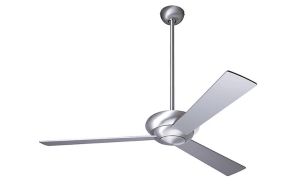Which Way Should Ceiling Fan Turn in Summer
Which Way Should Ceiling Fan Turn in Summer
In the summer, your ceiling fan should turn counterclockwise or in a “forward” direction when looking up at it. This direction creates a breeze that circulates air downward, making you feel cooler by evaporating moisture from your skin and creating a wind-chill effect. This can help you stay comfortable in warmer weather without having to lower the thermostat on your air conditioner. This specific fan rotation is recommended for several reasons:
- Cooling Effect: When the fan blades move counterclockwise, they push air downwards. This creates a gentle, artificial breeze in the room. As the air blows across your skin, it helps to evaporate moisture from your body, making you feel cooler. This is similar to the wind-chill effect you experience outdoors when the wind blows on a warm day.
- Air Circulation: Counterclockwise rotation also encourages better air circulation in the room. Hot air tends to rise, and a counterclockwise fan rotation helps push the hot air down from the ceiling and mixes it with cooler air near the floor, creating a more even temperature throughout the room.
- Energy Efficiency: Using a ceiling fan in this manner allows you to maintain a comfortable indoor temperature without having to set your air conditioner thermostat too low. This can result in energy savings and lower cooling costs during the summer.
To ensure that your ceiling fan is set to the correct direction for summer cooling, you can usually find a switch on the fan’s motor housing or remote control that allows you to change the fan’s rotation direction. If you’re unsure, consult your fan’s manual or look for a small switch on the fan itself to adjust the direction. Remember to turn off the fan before making any adjustments for safety.
Understanding Ceiling Fan Direction
The Two Fan Directions
Ceiling fans come equipped with a reversible motor, allowing them to rotate in two different directions: clockwise (or reverse) and counterclockwise (or forward). Each direction serves a specific purpose, making them suitable for different seasons. Visit our website for more information about different topics digitechslife.com
Counterclockwise Rotation (Forward) – Summer Mode
During the summer, you should set your ceiling fan to rotate counterclockwise or in the forward direction. This creates a gentle, downward airflow that produces a cooling breeze in the room.
Clockwise Rotation (Reverse) – Winter Mode
Conversely, in the winter, you should switch your fan to rotate clockwise or in the reverse direction. This helps to redistribute warm air trapped near the ceiling down to the living space, keeping your room warmer without needing to increase the thermostat setting.
Why Counterclockwise for Summer?
Wind Chill Effect
Setting your ceiling fan to rotate counterclockwise in the summer creates a wind chill effect. This means that the moving air helps evaporate moisture on your skin, making you feel cooler. It’s similar to the sensation you experience when a gentle breeze hits your face on a hot day.
Increased Comfort
With the right ceiling fan direction, you can set your thermostat a few degrees higher without sacrificing comfort. This can lead to significant energy savings on your cooling bills.
Tips for Maximizing Cooling Efficiency
Adjust Fan Speed
Experiment with different fan speeds to find the optimal setting for your comfort. Higher speeds generate a stronger breeze, while lower speeds create a gentler airflow.
Ceiling Fan Size Matters
Ensure your ceiling fan is appropriately sized for the room. Larger rooms require larger fans to effectively circulate air. Refer to manufacturer guidelines for sizing recommendations.

Clean Your Fan Regularly
Dust and dirt accumulation on fan blades can reduce efficiency. Clean your fan blades at least once a season to maintain peak performance.
Optimize Ceiling Fan Height
Install your fan at the right height. Generally, fans should be hung at least 7-9 feet above the floor and 10-12 inches below the ceiling for optimum airflow.
Consider Energy-Efficient Models
When shopping for a ceiling fan, look for models labeled as “Energy Star Certified.” These fans are designed to meet strict energy efficiency guidelines, helping you save even more on your cooling costs.
Conclusion
In conclusion, the direction your ceiling fan should turn in the summer is counterclockwise or in the forward direction. This setting creates a refreshing breeze and a wind chill effect that enhances your comfort on hot days. Remember to adjust your fan speed, clean your fan regularly, and install it at the correct height for maximum cooling efficiency.
FAQs
1. Can I leave my ceiling fan on all night during the summer?
It’s generally safe to leave your ceiling fan on overnight in the summer as long as it doesn’t make the room too cold. Adjust the fan speed to a comfortable level.
2. Does ceiling fan direction matter if I have an air conditioner?
Yes, it does. Using a ceiling fan in conjunction with your air conditioner can help distribute cool air more effectively, allowing you to set your thermostat higher and save energy.
3. Should I reverse my ceiling fan when the seasons change?
Yes, it’s a good practice to reverse your ceiling fan’s direction in the winter to help distribute warm air. Just remember to switch it back counterclockwise for summer.
4. Can a ceiling fan lower my energy bills?
Yes, by creating a wind chill effect and allowing you to set your thermostat higher, a ceiling fan can contribute to lower energy bills in the summer.
5. Is it essential to hire a professional to install a ceiling fan?
While hiring a professional is advisable for safety and proper installation, many ceiling fans come with detailed installation instructions that you can follow if you have some DIY experience.
